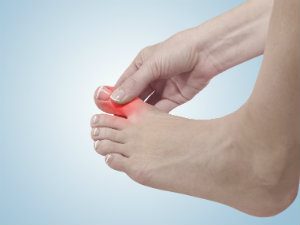You may have heard that there are over 100 different types of arthritis. We are discussing two of them here: hallux limitus and hallux rigidus. We want you to know about them, because the condition is progressive, and catching it early gives you your best chance of preventing serious difficulties in your feet.
Breaking Down the Terms

That’s a problem, because in a normal stride, the push off stage of your step requires the joint between toe and foot (the metatarsophalangeal joint—MTPJ) to bend about 65 degrees. When your toe can’t bend that far, you can have pain while walking, swelling in the joint, and gait alterations that can lead to problems elsewhere. Sometimes a bony bump develops on top of the bone—rather like a bunion does on the side—and keeps it from bending up.
Why Won’t My Toe Move?
The condition is believed to result from several underlying issues. One could be an injury to the toe that damages cartilage in the joint. Another could be an inherited foot structure that causes increased pressure on the MTPJ.
Rheumatoid arthritis (and the wear and tear kind called osteoarthritis) can both lead to damage to the cartilage in a joint. When the bones are not properly cushioned they can wear each other down and become deformed so the joint can’t move properly. The surrounding tissues can become swollen and inhibit movement, plus the irritation to tissues and the bones themselves can cause inflammation. All of these types of bone, joint and tissue damage combine to cause the pain you feel.
What to Do for Big Toe Pain
You can try wearing roomier shoes, or pads that cushion the toe from pressure. We may be able to design an orthotic to help relieve pressure on the joint as well. Sometimes you need to limit or stop the activities that make it hurt, like running.
Other remedies can include taking pain medication that we recommend, or we can try corticosteroid injections for pain relief. Icing may also help numb it and reduce swelling and inflammation.
Physical therapy may be another way to maintain range of motion in the toe and keep it from getting worse. This could include stretches to keep tendons and ligaments limber, as well as exercises to strengthen certain muscles.
When You Need to See Our Podiatrists
In the early stages of this condition, called hallux limitus, the toe can still move and there is more hope for maintaining normal function in the joint. This is the time when conservative treatments outlined above are most effective and may allow you to avoid surgery. We can evaluate the extent of your condition and design the best treatment for it.
Once the joint has deteriorated into total stiffness—hallux rigidus—these non-invasive therapies won’t help much, although they may relieve some of the pain. At that point surgery will likely be required to regain function or relieve your discomfort.
Surgery may include one of the following procedures:
- Cheilectomy – shaving the bone spur that has formed
- Osteotomy – cutting and realigning the bone
- Arthroplasty – using grafted tissue to repair the joint
- Arthrodesis – fusing bones in the joint together
Don’t Delay Getting Help from SoCal’s Foot Experts
This condition is best when tackled when symptoms first begin to show up, so call us as soon as you experience joint pain or stiffness in your big toe. We like to try conservative treatment first, but if surgery ends up being necessary, you have come to the right place. Our extensive knowledge, training, and experience in treating all types of foot problems makes us well qualified to care for your toe joint issues.
Call Southern California Foot & Ankle Specialists at our office in Ladera Ranch, CA by dialing (949) 364-9255 (WALK) to set up your appointment. Residents in the larger Saddleback Valley region may wish to schedule using our online form instead. Whatever method you use to contact us, do it today, and start the process of finding answers for your toe pain.
